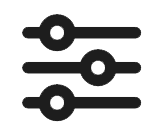The Coptic Orthodox Cathedral of Amsterdam
Coptic Orthodox Christians have been living in the Netherlands since the early 1960s. The first families came here to study and to find better career prospects. In the 1970s, many students came to the Netherlands during their Egyptian summer holidays to work in agriculture, factories, the hospitality industry or the car trade. Some wanted to stay and settled permanently in the Netherlands. If a Coptic Orthodox clergyman happened to be staying in the Netherlands, he took the opportunity to celebrate the Holy Liturgy. Until 1976, about three or four Divine Liturgies took place.
In the years that followed, the number of Coptic Orthodox families began to increase significantly. In 1976, Bishop Anba Markos, the Metropolitan of the Copts in France, visited the Netherlands. He met the families and then drew up an official church registration. Bishop Anba Athanasius and a priest from Paris also came to visit the church members. Once every two months, they celebrated the Divine Liturgy in a rented church in Amsterdam. On 30 May 1985, Father Arsenious El Baramousy became the first Coptic Orthodox priest to settle permanently in Amsterdam to serve the Copts in the Netherlands. He was sent by His Holiness Pope Shenouda III, Pope of Alexandria and the 117th successor of St. Mark the Evangelist. With his arrival, the Copts looked forward to having their own church and made every effort to find a suitable building. God led them to the current church building in Amsterdam North. On 2 October 1985, the purchase contract was signed and the church was transferred.
On Sunday, 20 October 1985, we celebrated the first Divine Liturgy in the new church and were delighted with this new house of God. After that, we were busy decorating the church in Coptic Orthodox style. From that time on, Holy Liturgies were held three times a week, supplemented by other weekly meetings and activities. We built an iconostasis, a children's room and a baptismal font. We also hung more than forty icons, which were designed especially for the church by icon painter Adel Nassief over a period of two years. We enriched the church interior with chandeliers in modern Coptic style, and the church hall and adjacent rooms on the first floor were renovated. In addition, we built a small chapel dedicated to Saint Mari Mina.
On Friday, 21 February 1992, His Holiness Pope Shenouda III himself cut the ribbon to open the church and unveiled the Dutch-language memorial stone, which had been made especially for this occasion. In the presence of 1,500 Copts, His Holiness consecrated the church, the altar, the icons, the Mari Mina chapel, the baptismal font and the other church attributes with Holy Oil in the name of the Blessed Virgin Mary. In addition to the enthusiastic faithful, nine spiritual dignitaries and 15 Coptic Orthodox priests from all over Europe were also present.
The church provides spiritual guidance to Orthodox Copts from Egypt, Sudan, Ethiopia and Eritrea. Dutch people who are connected to the church through marriage or who have independently converted to the Orthodox faith also belong to the church's sphere of influence. The church administers the Holy Sacraments to its members, such as baptism, communion, marriage and anointing of the sick. In addition, Bible study meetings are held, there is a Sunday school for various age groups, youth meetings are organised, and home visits are made. The church also pays attention to the social life of its members; it provides advice on legal matters, holds medical consultations, and provides material assistance, visits to the sick, and end-of-life care.
The church accompanies its members in all stages of life:
- At births, the priest visits the home and praises and thanks God, together with the parents, friends and acquaintances.
- Later, the priest baptises the child. This ceremony has a joyful character.
- When a believer falls ill, the priest performs an anointing for the sick at home.
- If a believer has problems, the church performs the Holy Liturgy for him or her.
- In the event of a death, the church holds a joint funeral service and assists the family, especially on commemorations on the third and fortieth days after the death.
The church is not just an institution but a family that brings each person together in love during the most sacred moments of worship. Some children are ordained as Liturgy Servers from the age of three. As young adults, they help out in Sunday school. In this way, the second generation experiences that they are given an important role in the church and grows up in the church. In this way, we can preserve the second generation for the church and later transfer responsibility to them. The church considers the translation of the Coptic Orthodox heritage into Dutch to be important. Many spiritual works, such as the books of His Holiness Pope Shenouda III and books explaining the Coptic Orthodox faith, have already been translated.
The Divine Liturgy (Coptic Orthodox Church)
A service to the people in which rituals and prayers are performed according to a set pattern. The service of the Divine Liturgy includes specific readings. In the context of the Oriental Orthodox Church, of which the Copts are a part, the Eucharist is central to the Divine Liturgy.
Icon
Eastern Christian religious image. Icons are usually depictions of Christ, Mary, saints and church feasts painted in tempera on wood. Icon veneration occupies an important place within the spirituality of the Christian East and effectively brings the believer into contact with the world of divinity.
Coptic Diocese of the Netherlands
The Holy Synod of the Coptic Orthodox Church has decided to establish a diocese for the spiritual care of Copts in the Netherlands. During the evening incense prayer on 15 June 2013 (9 Baoena 1729 AM), Pope Tawadros II, Pope of Alexandria and Patriarch of the Coptic Orthodox Church, the consecration of Hegumen Arsenious el Baramousy as the first Bishop of this Diocese, with the name Anba Arseny, Bishop of the Diocese of the Netherlands. Anba Arseny graduated from the Faculty of Medicine in 1975. On 20 September 1978, he became a monk at the El Baramous monastery in Wadi-Natroun, Egypt. He was then ordained as a priest on 30 May 1979 and Hegumen on 2 July 1981. He served in the Diocese of Za'aziek and Minya el Amh as the person responsible for the spiritual care of young people from 9 January 1980 to 24 January 1982. He then served as interim abbot of the El Baramous monastery from 11 February 1982 to 30 April 1984. His Holiness Pope Shenouda III chose him to serve the Coptic community in the Netherlands on 30 May 1985.
We always try to preserve the specificity of the Coptic Orthodox faith, but with modern means and in understandable language. The Divine Liturgy is recited and sung in Dutch, and hymns and scriptural readings are also translated into Dutch but performed in a Coptic melody at the same time.
The Coptic Orthodox Church is in constant contact with Protestant and Catholic churches in the Netherlands. Both clergy and laity exchange visits. We also have contact with the Russian Orthodox and Greek Orthodox churches and, of course, with the churches that are most similar to us in terms of faith: the Syrian Orthodox and Armenian churches.
In conclusion, we would like to say that we see God's hand in the history of the Coptic Orthodox Church. That is why we also believe that its future is in His hands.
Leden van de Projectcommissie van het Koptisch-Orthodoxe Bisdom van Nederland
Last edited
June 03, 2025




